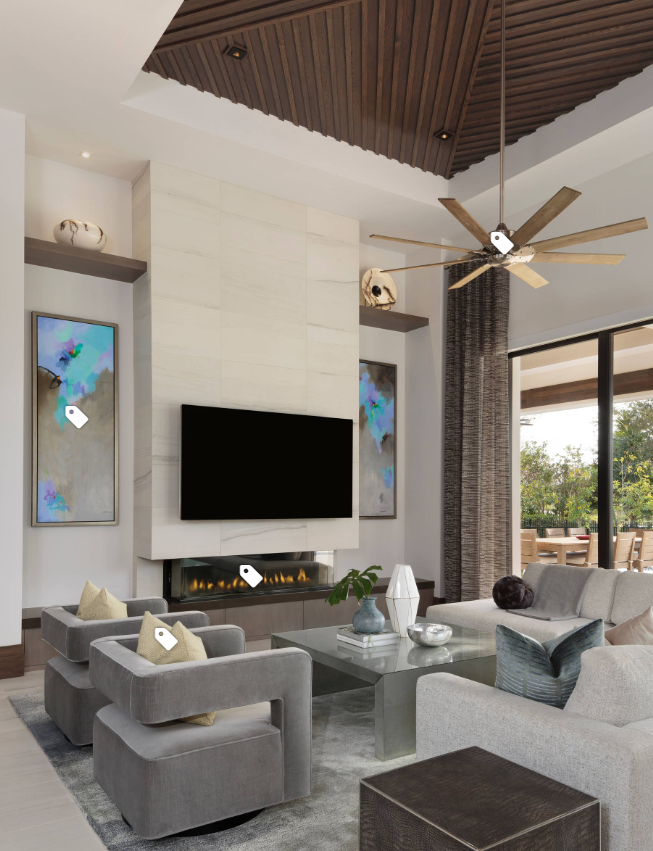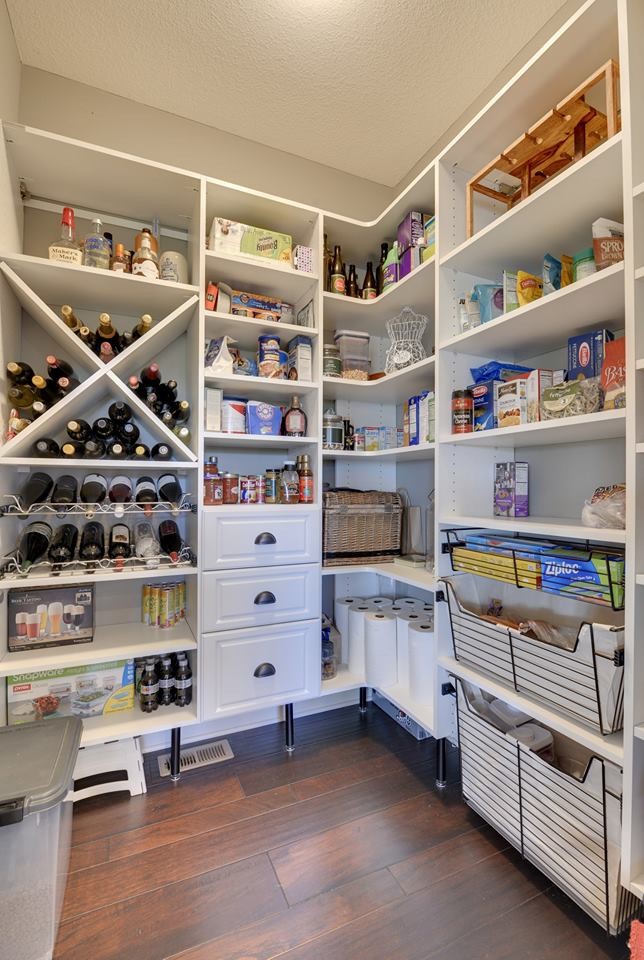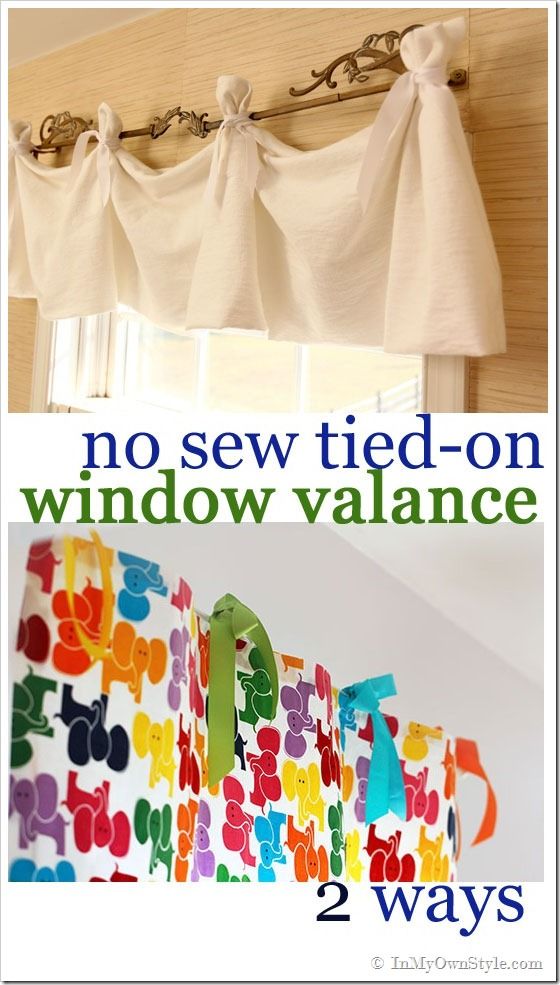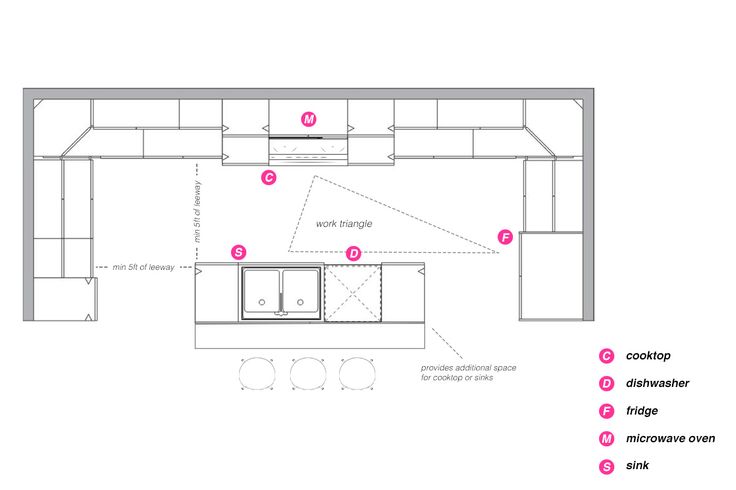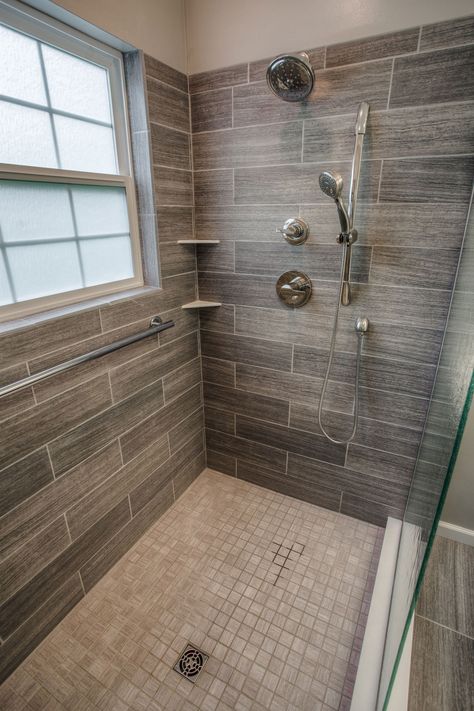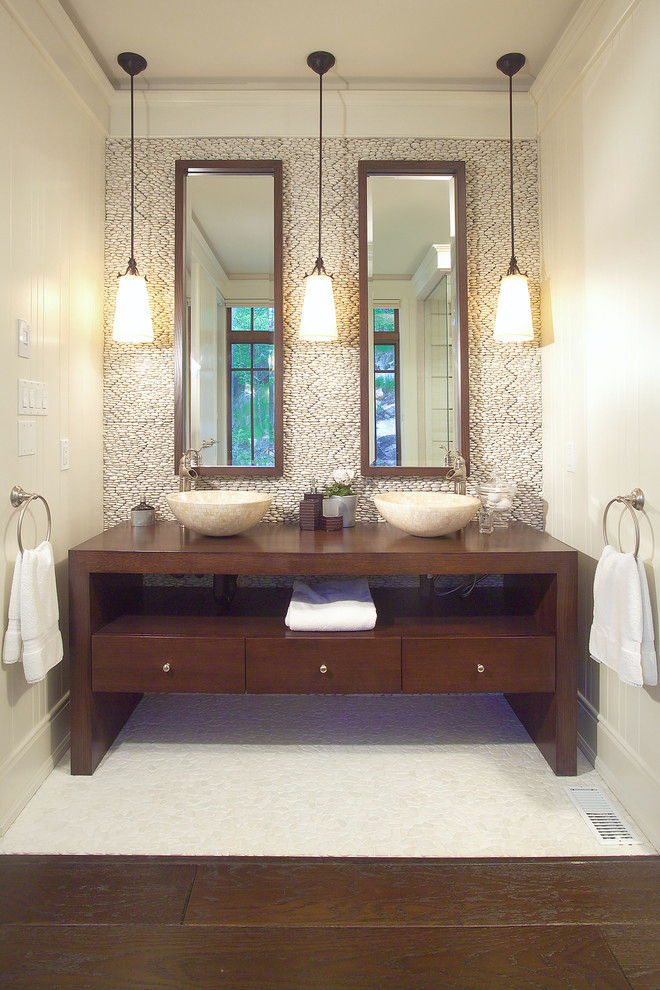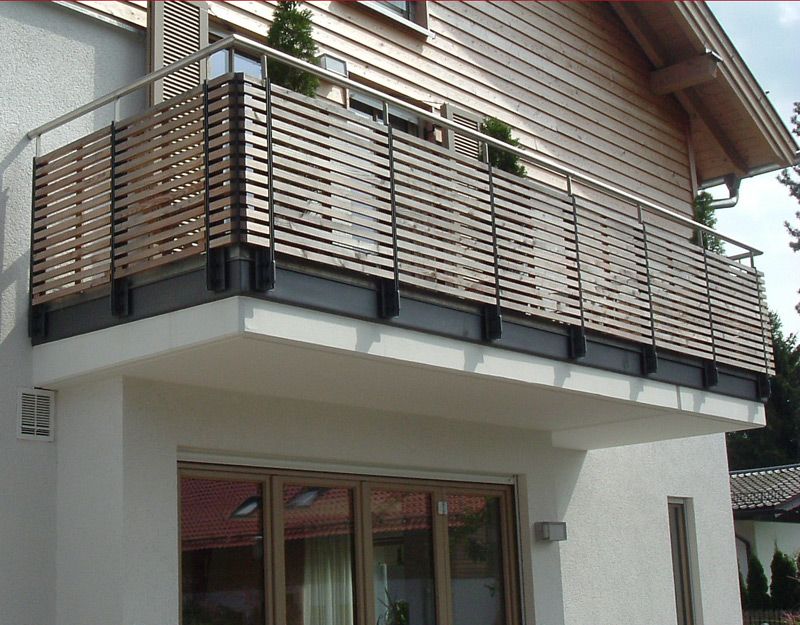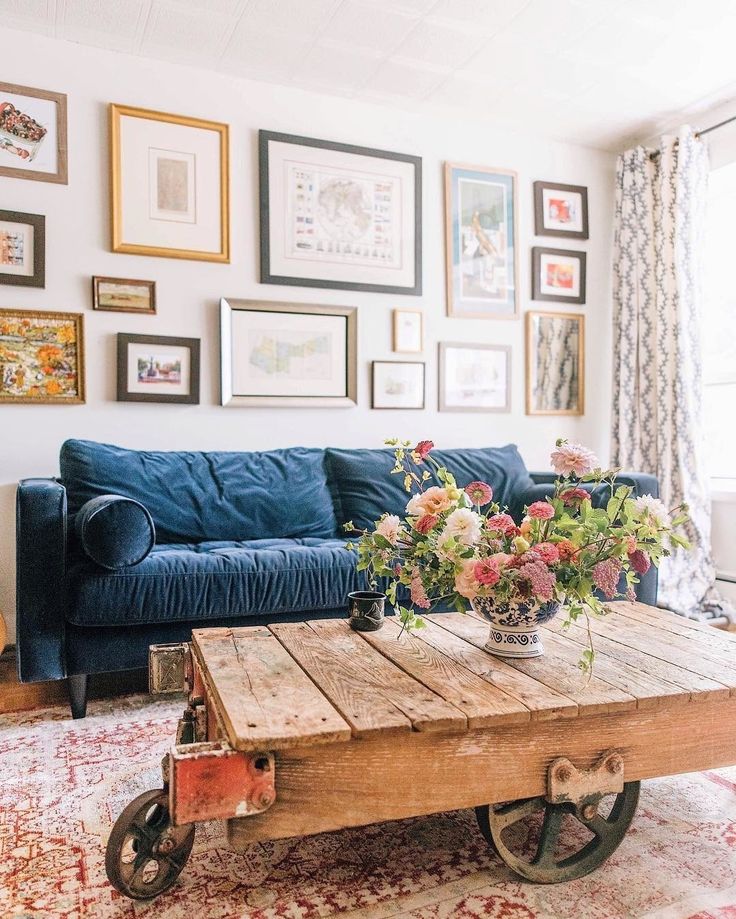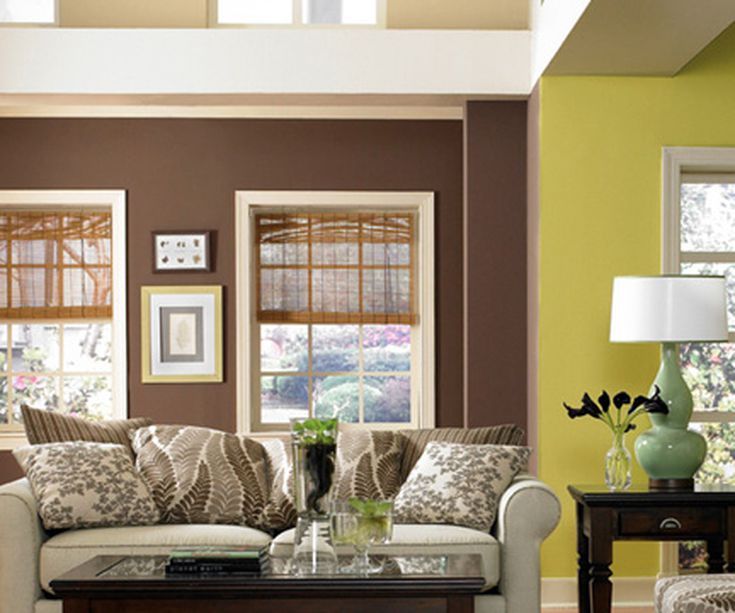Best evergreen small trees
15 Exceptional Choices for the Yard and Garden
If you’re looking for evergreen trees that stay naturally short-statured, have no maintenance requirements beyond watering, and stay green all winter long, you’ve come to the right place! While finding all of these traits in a single tree might seem too good to be true, it isn’t. In fact, there are lots of dwarf evergreen trees that offer all of these benefits and more to small-space gardeners. They’re also great choices for anyone who doesn’t want to spend their weekends pruning overgrown plants. Before I introduce you to 15 of my favorite small evergreen trees, let’s take a look at some of the perks these plants provide.
Why plant small evergreen trees?
There are many benefits of planting small evergreen trees in your yard and garden.
- Their naturally compact form means little, if any, pruning is necessary to maintain their small stature
- Their evergreen nature means you’ll have color and texture in the garden year-round.
- Dwarf evergreen trees make great privacy screening without growing too large.
- The small stature of these plants make them easy to plant; there’s no wrestling with a huge root ball or long branches.
- Dwarf evergreens provide winter habitat for many different birds, and those that produce cones provide food as well.
- The compact evergreen trees on this list are low maintenance and tolerant of a wide range of growing conditions. This makes them great choices for folks who don’t have a lot of time to maintain their plantings.
Top 15 dwarf evergreen trees for small gardens
While there are hundreds of compact evergreens for small gardens, these 15 are exceptional varieties I’ve personally worked with. As a horticulturist, I see lots of evergreen trees and shrubs worth growing. But, those on this list are among the finest small-statured varieties available to home gardeners.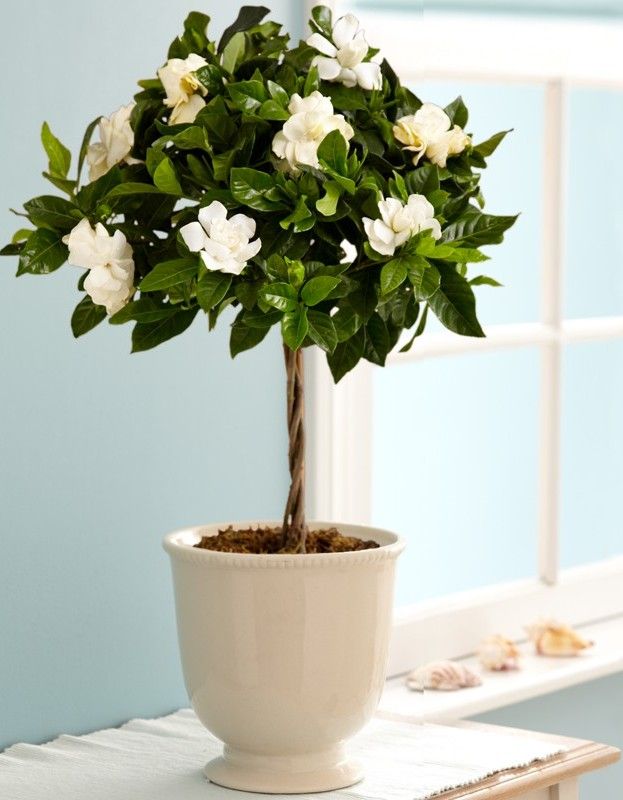
1. The Blues Weeping Colorado Spruce (Picea pungens ‘The Blues’): This amazing and extremely hardy variety of weeping blue spruce is a total show-stopper. Though it’s fast growing, it tops out at just 10 feet in height with a width between 5 and 10 feet. The blue-green needles are thickly packed on downward hanging branches. Hardy down to -50 degrees F, ‘The Blues’ is among the most deer resistant of the dwarf evergreen trees. It thrives in full sun conditions but will also tolerate some shade.
The weeping habit of ‘The Blues’ adds an extra layer of interest to the garden.2. Hinoki Cypress (Chamaecyparis obtusa): A compact, extremely slow-growing, soft-needled evergreen with a somewhat pyramidal form, Hinoki cypress have fan-shaped foliage that’s lush and dark green. It gives the plant an almost feathery texture. Winter hardy down to -30 degrees F, Hinoki cypress are 10 to 12 feet tall and 3 to 4 feet wide when twenty years old.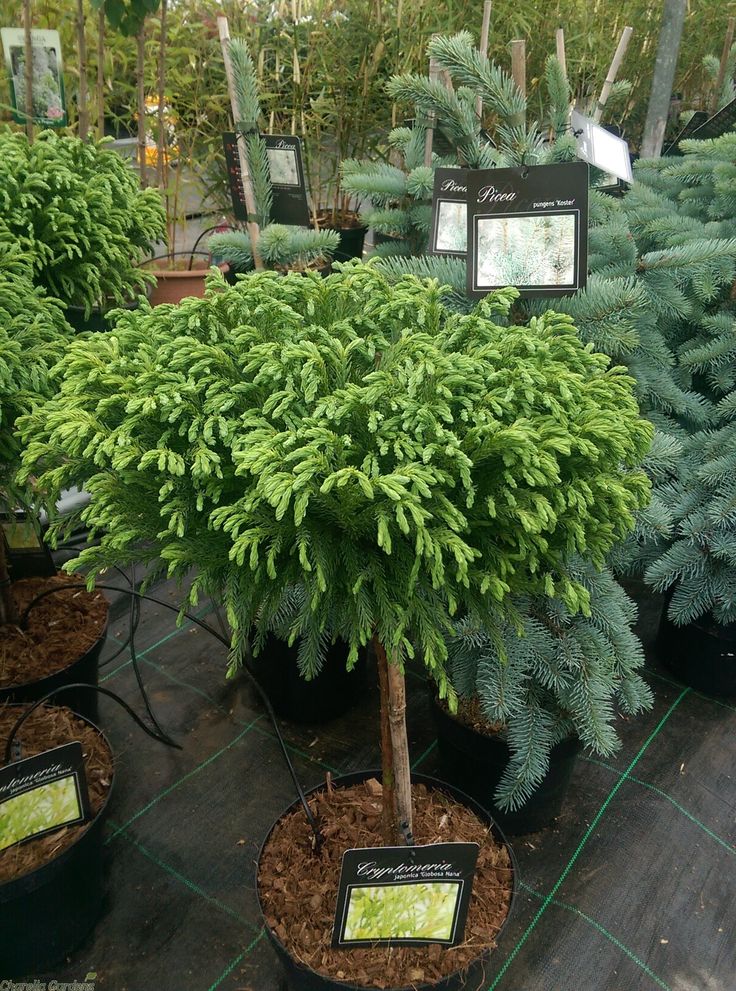 This evergreen requires full to partial sun and well-drained soils. If you’d like an even smaller version of this plant that tops out at just 5 feet tall, look for the cultivar ‘Nana Gracilis’. For a complete article on caring for the compact version of this evergreen, please visit our article titled Dwarf Hinoki Cypress.
This evergreen requires full to partial sun and well-drained soils. If you’d like an even smaller version of this plant that tops out at just 5 feet tall, look for the cultivar ‘Nana Gracilis’. For a complete article on caring for the compact version of this evergreen, please visit our article titled Dwarf Hinoki Cypress.
3. Blue Wonder Blue Spruce (Picea glauca ‘Blue Wonder’): This sweet little spruce is winter hardy down to -40 degrees F. It has beautiful blue-gray foliage and a lovely compact form. This dwarf evergreen is an excellent alternative to dwarf Alberta spruce and it looks great in winter container plantings, too. Slowly reaching 6 feet in height, ‘Blue Wonder’ is only 3 feet wide at maturity and has a naturally dense conical form.
4. Dwarf Balsam Fir (Abies balsamea ‘Nana’): A squat, rounded fir with lush needles, this compact plant deserves a place on every list of dwarf evergreen trees.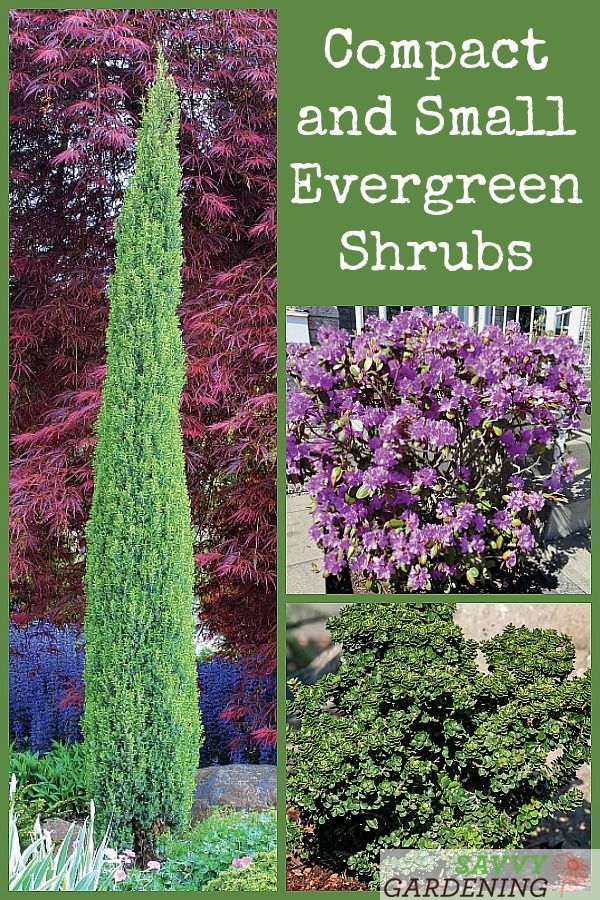 Hardy to -40 degrees F, the slow growth rate of this variety makes it great for folks who don’t have the time or inclination to regularly prune their shrubs. Like other balsam firs, this compact selection has dark green needles and densely packed branches. It reaches 5 to 6 feet wide after many years of growth.
Hardy to -40 degrees F, the slow growth rate of this variety makes it great for folks who don’t have the time or inclination to regularly prune their shrubs. Like other balsam firs, this compact selection has dark green needles and densely packed branches. It reaches 5 to 6 feet wide after many years of growth.
5. Chalet Swiss Stone Pine (Pinus cembra ‘Chalet’): Swiss Stone pines have long been a favorite of mine, and this dwarf variety is no different. When it comes to dwarf evergreen trees, ‘Chalet’ has so much to offer! Slow growing with a beautiful form, this small evergreen tree is columnar in shape and densely branched. The needles are long and blue-green, lending a soft look to this compact evergreen. With a hardiness down to -40 degrees F, ‘Chalet’ is an exceptional choice that reaches just 8 feet in height with a width of 4 feet.
No matter what their variety, Swiss Stone pines are among the finest dwarf evergreen trees on the market.6. Tip Top Dwarf Swiss Stone Pine (Pinus cembra ‘Tip Top’): So, just to prove I wasn’t kidding about loving Swiss Stone pines, here’s another variety of these dwarf evergreen trees worth planting in small gardens. ‘Tip Top’ is extremely hardy (-40 degrees F) and downright adorable. In 10 years it reaches just 6 feet tall and 3 feet wide. The white undersides of the needles, combined with their long form and soft feel, make this evergreen look like a shaggy green Muppet. Its growth habit is narrow and conical, and like all of the other dwarf evergreen trees on this list, ‘Tip Top’ requires zero pruning to maintain its small stature.
Tip Top Dwarf Swiss Stone Pine (Pinus cembra ‘Tip Top’): So, just to prove I wasn’t kidding about loving Swiss Stone pines, here’s another variety of these dwarf evergreen trees worth planting in small gardens. ‘Tip Top’ is extremely hardy (-40 degrees F) and downright adorable. In 10 years it reaches just 6 feet tall and 3 feet wide. The white undersides of the needles, combined with their long form and soft feel, make this evergreen look like a shaggy green Muppet. Its growth habit is narrow and conical, and like all of the other dwarf evergreen trees on this list, ‘Tip Top’ requires zero pruning to maintain its small stature.
7. Dwarf Serbian Spruce (Picea omorika ‘Nana’): The dense growth of this compact evergreen tree makes it a super choice for small garden beds and foundation plantings. Like other Serbian spruces, this dwarf form has green needles with white striping on the undersides, giving the tree a soft appearance. Slow-growing and reaching a maximum height of just 3 to 5 feet with an equal width, dwarf Serbian spruce thrives in garden zones with winter temperatures down to -30 degrees F.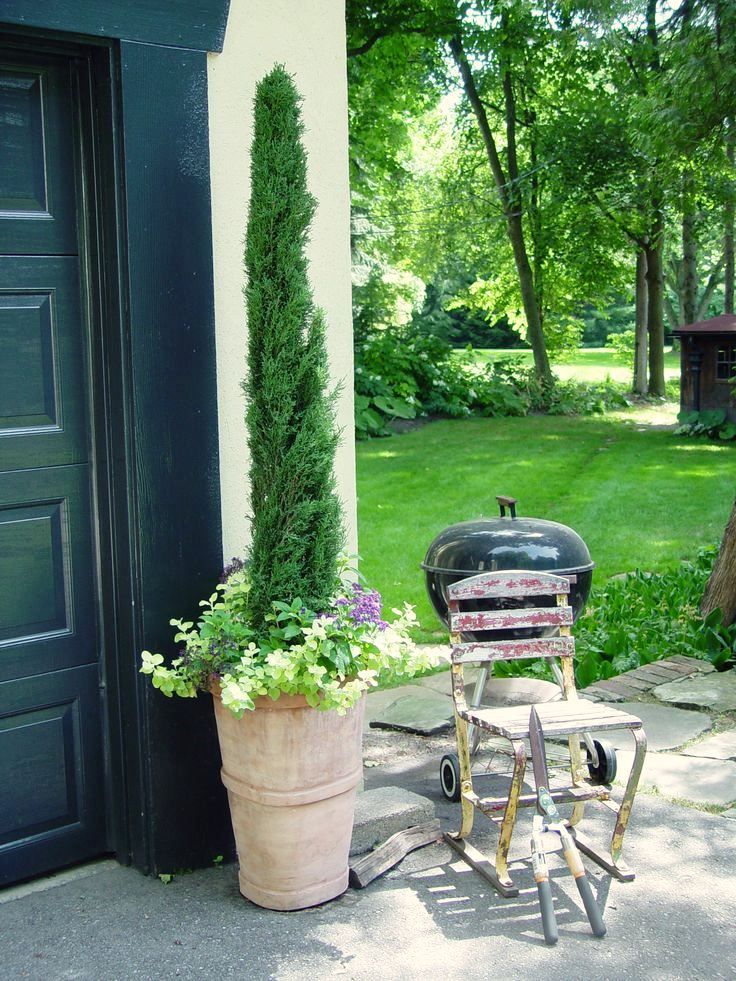 Loosely pyramidal in form with no pruning required.
Loosely pyramidal in form with no pruning required.
8. Green Spire Euonymus (Euonymus japonicus ‘Green Spire’): Winter hardy down to -10 degrees, ‘Green Spire’ euonymus is well behaved, giving it a more formal appearance than some other options. The glossy, green foliage is perfect for creating a narrow hedge or screen. Maxing out at 6 to 8 feet in height with a spread of just 1 to 2 feet, this naturally narrow shrub is a fast grower, too.
9. Green Arrow Weeping Alaska Cedar (Chamaecyparis nootakatensis ‘Green Arrow’): Tall and narrow, ‘Green Arrow’ is one of the finest narrow evergreen trees for small yards and gardens. Of all the weeping Alaska cedars, ‘Green Arrow’ offers the most slender girth. Topping out at 20 feet in height and 1 foot wide, you might not consider it dwarf, but it’s super small footprint makes it great for even the tiniest of backyards.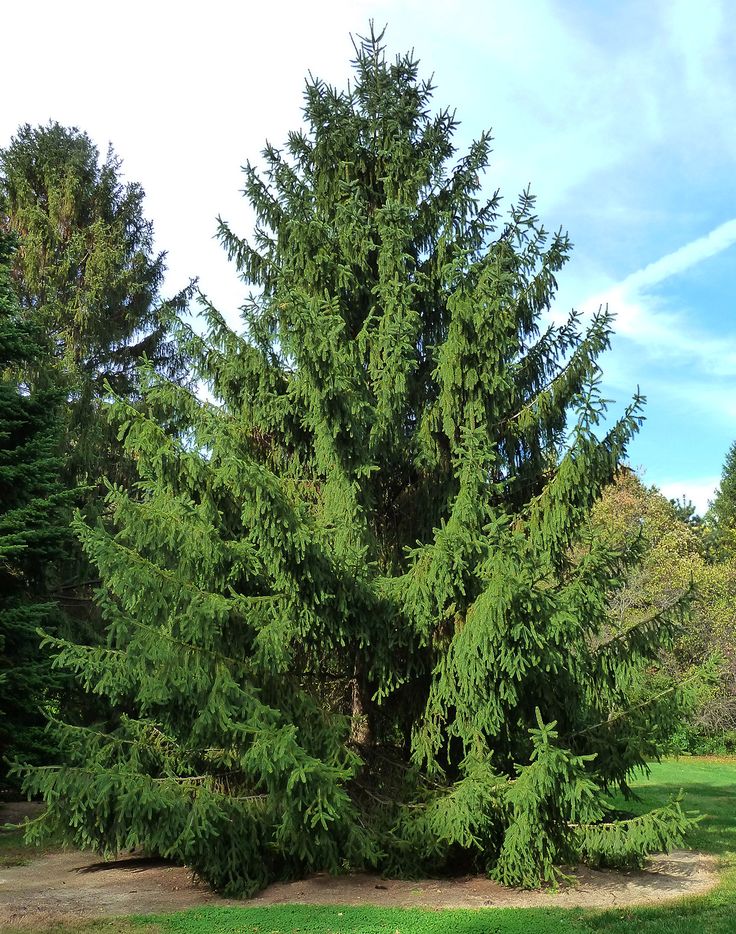 The weeping branches have soft foliage with a fan-like appearance. Winter hardy down to -20 degrees F, ‘Green Arrow’ makes a phenomenal addition to the garden.
The weeping branches have soft foliage with a fan-like appearance. Winter hardy down to -20 degrees F, ‘Green Arrow’ makes a phenomenal addition to the garden.
10. Green Penguin Dwarf Scotch Pine (Pinus sylvestris ‘Green Penguin‘): A chunky, yet tidy dwarf evergreen, once you see ‘Green Penguin’ you’ll realize how it got its name. With new growth that’s feathery and older growth that’s long-needled, this dwarf scotch pine is very unique. It has a thick, pyramidal form that never has you reaching for your pruning shears, and ‘Green Penguin’ is hardy to -40 degrees F. Maximum height is 6 feet with a width equal to half its height.
11. Dwarf Japanese Black Pine (Pinus thunbergii ‘Kotobuki’): Fully winter hardy to -20 degrees F, this needled evergreen reaches just 4 feet tall and 2 feet wide.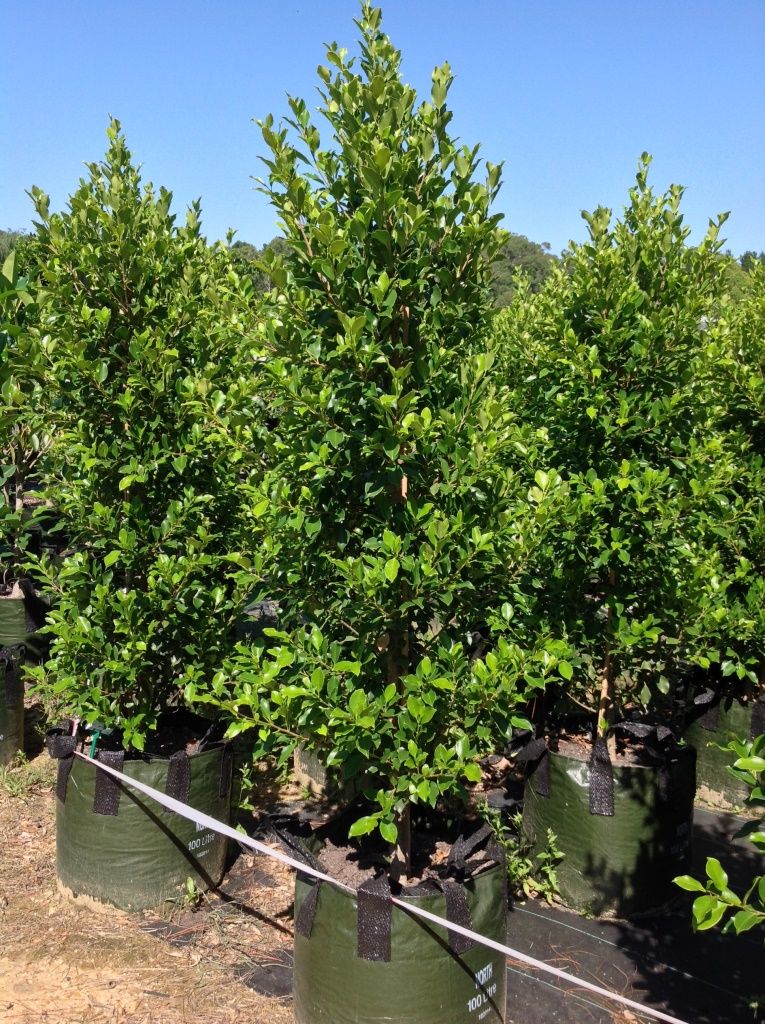 The upright candles of new growth in the spring, coupled with its narrow growth habit, make ‘Kotobuki’ an excellent choice for containers and small gardens. Slow growing, with a dense structure, this deer-resistant evergreen has needles that are about half the length of regular Japanese black pines.
The upright candles of new growth in the spring, coupled with its narrow growth habit, make ‘Kotobuki’ an excellent choice for containers and small gardens. Slow growing, with a dense structure, this deer-resistant evergreen has needles that are about half the length of regular Japanese black pines.
12. Dwarf Pencil Point Juniper (Juniperus communis ‘Compressa’): Evergreen and columnar in form, dwarf pencil point juniper is both unique and slow growing. With an average height of 5 feet and a width of just 1 foot, this sun-loving evergreen has blue-green needles. Female plants may produce blue “berries” in the fall as well. Its tapered form means it’s a great “exclamation point” accent plant for smaller landscapes. Winter hardy to -40 degrees F.
13. North Star Dwarf White Spruce (Picea glauca ‘North Star’): Extremely hardy, this compact evergreen tree is pyramidal in shape and covered with green needles. Deer-resistant and hardy to -50 degrees F, ‘North Star’ tops out at 5 to 10 feet tall and 4 feet wide. It prefers full to partial sun and requires little to no pruning to maintain a neat-and-tidy shape. Easy to grow and tolerant of all but the wettest soils, ‘North Star’ is among the finest dwarf evergreen trees available.
Deer-resistant and hardy to -50 degrees F, ‘North Star’ tops out at 5 to 10 feet tall and 4 feet wide. It prefers full to partial sun and requires little to no pruning to maintain a neat-and-tidy shape. Easy to grow and tolerant of all but the wettest soils, ‘North Star’ is among the finest dwarf evergreen trees available.
14. Upright Japanese Plum Yew (Cephaloxatus harringtoniia ‘Fastigiata’): This broad-needled evergreen is hardy to -10 degrees F. Its upright, slender growth habit maxes out at 8 feet tall and 3 feet wide. Though it’s non-flowering, Japanese plum yews have dark green needles that are densely spaced on bottlebrush-like, upright branches. Each needle is about 2 inches long. It thrives in full to partial sun, but prefers afternoon shade in hot southern regions during the summer months.
The upright branches of the Japanese plum yew mean it doesn’t take up much room in the garden.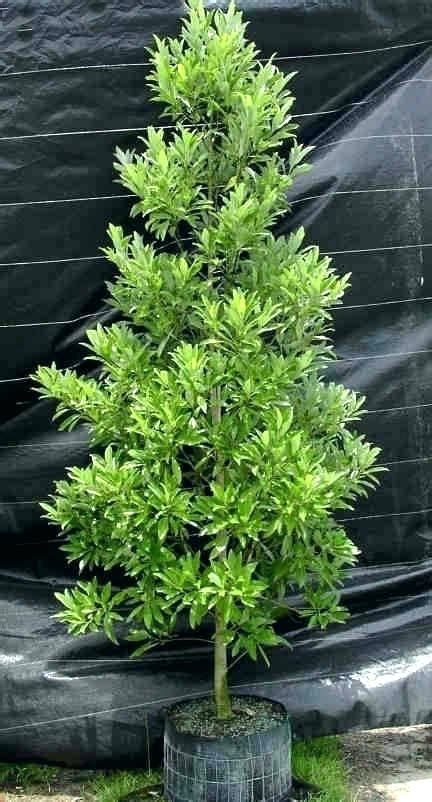
15. Little Gem Dwarf Southern Magnolia (Magnolia grandiflora ‘Little Gem’): Like its full-sized kin, this compact southern magnolia is lush and attractive. The leaves are just as dark green and glossy as traditional southern magnolias, but they’re smaller in size. Large, white, perfumed flowers cover this columnar dwarf evergreen tree in late spring through summer. A second bloom may occur again in the fall in cooler climates. While at a mature height of 20 feet tall, ‘Little Gem’ certainly isn’t as petite as some of the other trees featured here. But, it is significantly smaller than a standard southern magnolia and is one of the finest dwarf evergreen trees available. Winter hardy down to 0 degrees F.
The ease of maintenance, beauty, and diversity of these dwarf evergreen trees is hard to deny. There’s no doubt making a home for one or more of them in your garden pays big dividends all year long.
For more on using compact plant varieties in your garden, check out the following articles:
- Dwarf Flowering Shrubs for Small Gardens and Landscapes
- The Best Evergreen Trees for Privacy Screening
- Shrubs that Flower in the Shade
- Narrow Trees for Small Gardens and Tight Spaces
- Evergreen Groundcover Plants: 20 Choices for Year-round Interest
- Colorful Shrubs for Season-long Beauty
- The Beauty of Weeping Alaskan Cedar Trees
What are your favorite compact evergreen trees? We’d love to hear about them in the comment section below.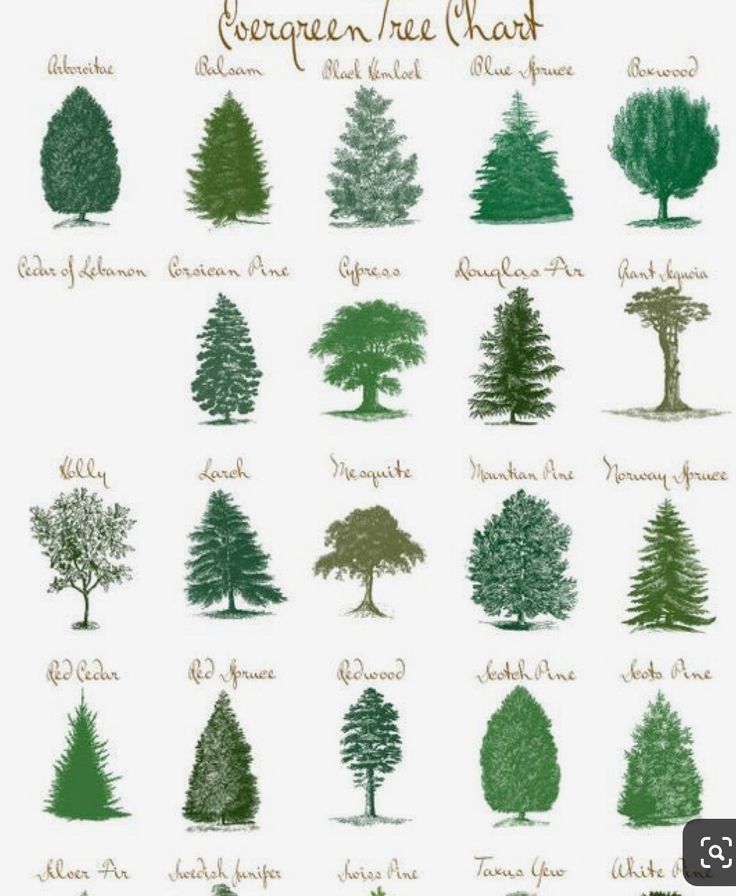
Evergreen trees for gardens: 10 of the best choices
Finding out about the best evergreen trees for gardens and adding a few to your plot will totally transform your outdoor space year-round, and especially during the desolate winter months.
As the red and orange leaves fall off deciduous trees, leaving bare, skeletal bones, it is in winter that we come to truly appreciate the beauty of evergreen trees. Bringing life and color to the now sleeping garden, they are a stalwart that see us through winter and provide the backbone of our backyard ideas.
Evergreen trees for gardens
With their thick green leaves that last all year-round, evergreen trees are some of the best trees for privacy in a backyard. Not only do they hide unsightly views and offer a feeling of seclusion in your garden, but they can also reduce sound pollution, helping to create a sanctuary where you can immerse yourself in nature.
What to consider when choosing evergreen trees for gardens
When selecting the right evergreen tree for your plot, it is vital that you consider the climate in which you live – some trees are evergreen in one climate but deciduous in another.
You also need to think about the tree's size and the amount of shade it will cast. In the winter, light is limited, so you need to be careful not to cast large shadows over your house, as this will make it colder and can even increase your heating bill – in which case, you might want to research the best trees for a small garden – or the best trees for front yards, which will be naturally more compact.
Before you start searching, select the spot for your new tree as this will inform the size and growth rate that you require. Think about where it will cast its shadows and how it will look when fully grown.
It is also key to consider your soil type and the light levels of your spot – picking a tree that is well-suited to both of these conditions will help it to thrive. You might also want to learn how to plant a tree so that you can give your evergreen tree the best start.
Having worked out these parameters, you are then ready to find the best evergreen tree for your garden.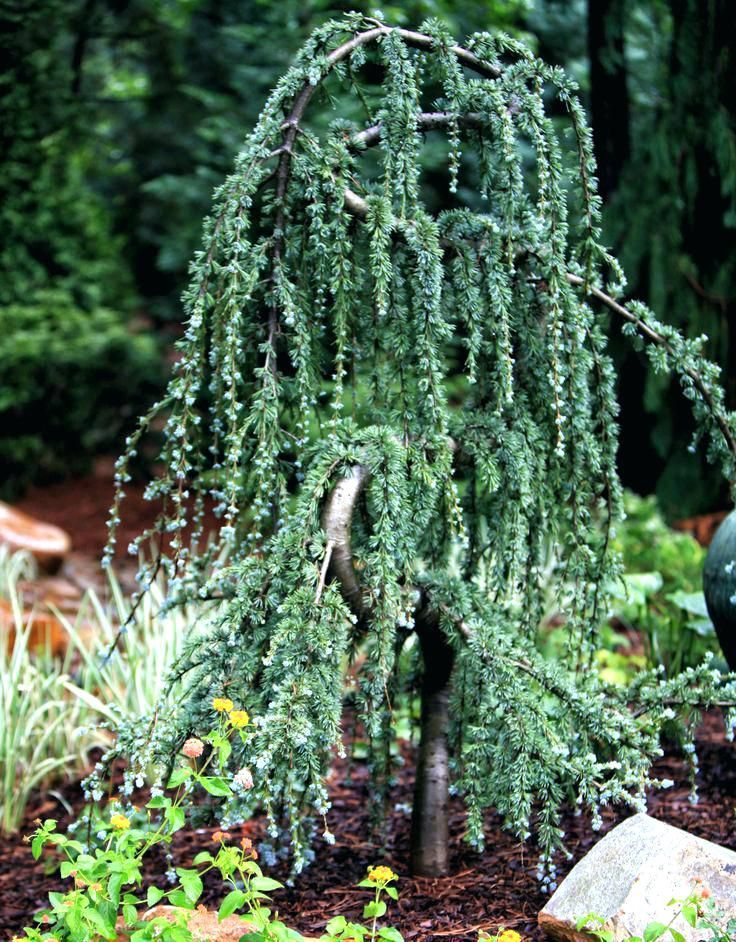
1. Magnolia grandiflora
(Image credit: Getty Images)
Magnolias are one of the prettiest evergreen plants for gardens. With verdant green leaves and their fragrant citrusy flowers blooming in the spring, magnolia trees make a statement in every season.
However, many magnolia trees are deciduous, so if you're looking for evergreen trees for gardens, be sure to select the Magnolia grandiflora variety. Native to the South Atlantic states, they are a highly adaptable tree and grow in a wide variety of soils, though they thrive best in moist but well-drained, mildly acidic soils.
'Magnolia grandiflora is a large plant with an average height and width of 30-45 feet. The broad leaves are glossy green and held at a 45 degree angle from the stems. In spring, it bears white to pink blooms that add to the appeal of its landscape value,' explains Lindsey Hyland, founder of Urban Organic Yield .
2. Fraser’s Photinia (Photinia x fraseri)
(Image credit: Getty Images)
A fast growing tree, Fraser’s Photinia can grow up to 3ft per year making them one of the best trees for privacy and screening in a backyard.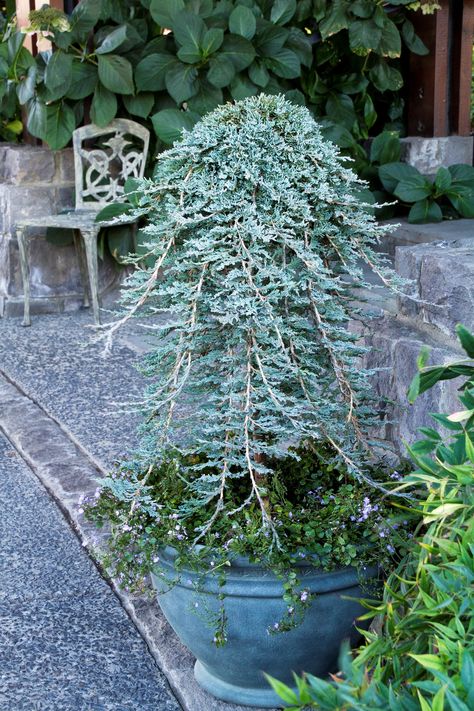 Thriving best in full sun and hardy in zones 7 to 9, they offer a profusion of color all year round. Their new foliage emerges bright red, adding a firey hue to the rich green of the older leaves, and then explodes in white blooms come the spring.
Thriving best in full sun and hardy in zones 7 to 9, they offer a profusion of color all year round. Their new foliage emerges bright red, adding a firey hue to the rich green of the older leaves, and then explodes in white blooms come the spring.
Taking around 12 years to grow to full size, they are an extremely versatile addition to the garden, and can be grown as a shrub, hedge or standard tree. They can even be espaliered against a wall for added architectural interest. If you do clip them into a standard shape, as above, it makes them a great choice if you are planning on landscaping around trees in your backyard.
3. Holly trees
(Image credit: Getty Images)
There are two main types of evergreen holly that are popular throughout the US. The first are the English hollies, which are the typical festive holly tree, recognizable by its slightly curled spiky leaves. Variegated English holly trees have dark leaves with white edges creating an interesting and unusual addition to the garden.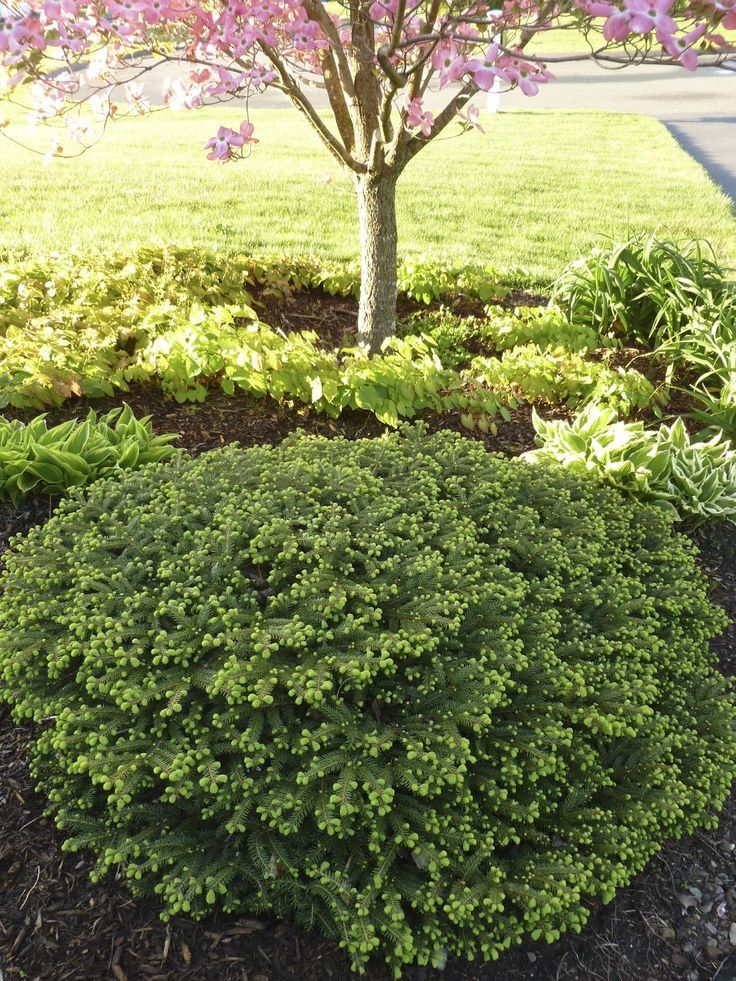 Their thick canopy but smaller size, usually around 25ft, makes them ideal evergreen trees for gardens.
Their thick canopy but smaller size, usually around 25ft, makes them ideal evergreen trees for gardens.
American holly trees are very similar though there are some key differences. These trees are larger, growing to around 60ft, and have a lighter leaf color and subtly different berries.
With both of these holly trees, if you want to produce berries – which are great for feeding birds in winter – then be sure you have 'one male for every one to five females for fruit to form,' advises garden expert and arborist Melinda Myers .
For best results, Melinda advises that you plant in moist acidic soil and select a variety that is suited to your growing conditions, 'for easy care and best results, shelter from drying winter winds.'
4. Juniper
(Image credit: Getty Images)
Best known as the key ingredient in gin, juniper trees are actually a worthwhile addition to the garden in their own right. A type of conifer, they are praised for their versatility and hardy in zones 3 through to 9.
'Junipers come in various colors and can grow in soils that are difficult to grow other plants. With all of the different varieties available, you’ll easily be able to find one that fits in with your garden. Most junipers do best in full sun, though a few like the shade in the late afternoon,' recommends Emilly Barbosa Fernandes, small space gardener at House Grail .
Junipers also suit a variety of different styles, the tree can be pruned into a neat triangular shape, or can be left to grow more naturally for a more rustic appearance.
5. Hemlock (Tsuga)
(Image credit: Getty Images)
Hemlock is a type of evergreen fir tree praised for its versatility. There is a variety to suit almost all conditions throughout the US, from the Canadian Hemlock which thrives from zones 3 to 8; to the Western Hemlock which grows in zones 6 to 8 and will even grow in the densest shade. Plus, there are the Eastern and Caroline hemlocks which are also great evergreen trees for gardens.
Loved for their pyramidal shape, dark, evergreen needles and decorative cones, they are a popular evergreen tree for backyards.
'More shade tolerant than most evergreens, they need protection from drying winter winds and sun. Therefore it is important to plant in an appropriate location with adequate moisture, good drainage and cool acidic soil,' advises gardening expert and arborist Melinda Myers.
6. Scarlet Firethorn (Pyracantha coccinea)
(Image credit: Leigh Clapp)
Characterized by deep red berries, thorny stems and dense foliage, Pyracantha coccineas offer a host of benefits to the garden. Their berries are loved by birds, and the vivid red of them makes them one of the best trees for autumn color. The thorny foliage offers a safe space for our feathered friends to nest during the spring and summer, too.
Growing up to 10 feet tall and offering a host of sharp stems and thick foliage, Pyracantha coccineas can be grown to increase the security and privacy of your home and garden.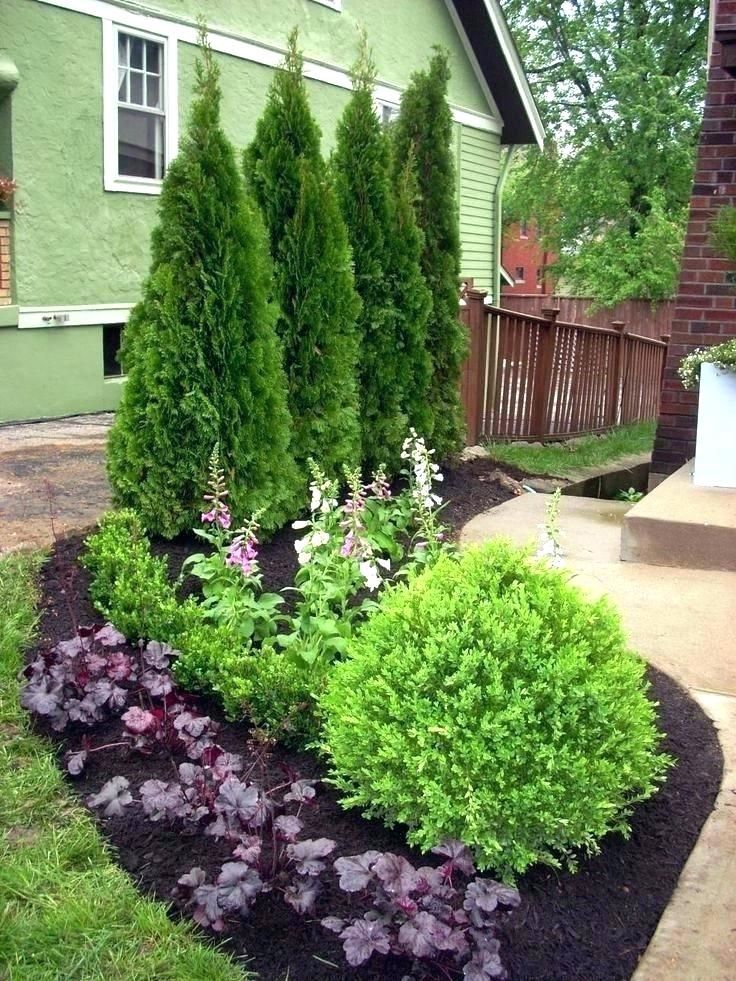 What's more, Pyracantha coccinea is one of the most durable evergreen trees for gardens making it perfect for those who are less confident in gardening. They grow well in both full and partial sun and can thrive in almost all soil types including chalk, clay, loam and sand.
What's more, Pyracantha coccinea is one of the most durable evergreen trees for gardens making it perfect for those who are less confident in gardening. They grow well in both full and partial sun and can thrive in almost all soil types including chalk, clay, loam and sand.
7. Shore Pine (Pinus contorta 'Chief Joseph')
(Image credit: Getty Images)
Pines are one of the most popular evergreen trees for gardens, however, Shore Pines offer something a little different. Unlike their larger relatives, Shore Pines are fairly petite with a slow growth rate. This makes them great evergreen trees for gardens that are on the smaller side – they can even be grown in a pot.
However, what makes these evergreen trees really special is their color. Throughout summer and fall, the leaves are not particularly noteworthy, though they do offer a rich green backdrop for other plantings, but come the winter and spring, they are transformed into a captivating golden hue that brightens even the darkest plot.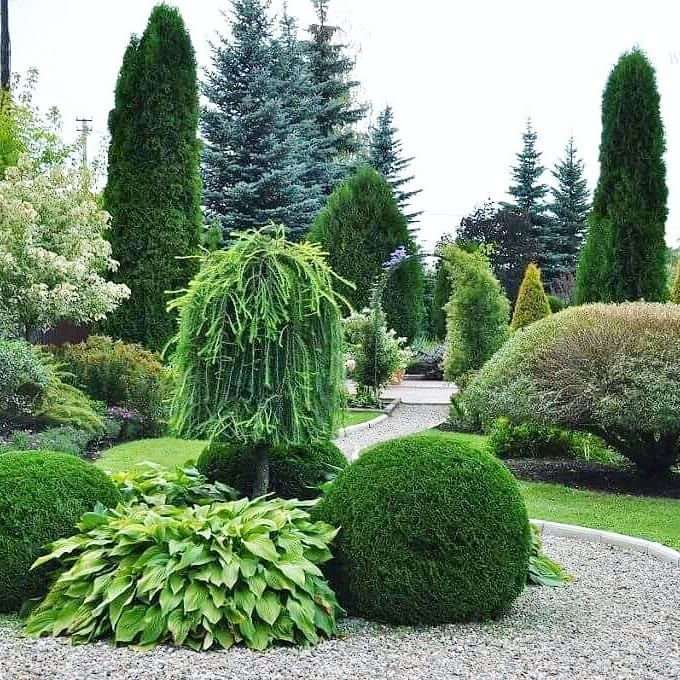 Consider pairing with hellebores for a beautiful winter border.
Consider pairing with hellebores for a beautiful winter border.
8. Strawberry tree (Arbutus unedo)
(Image credit: Getty Images)
A rather understated choice, strawberry trees are amongst the best evergreen trees for gardens due to their unusual character. With peeling bark, evergreen foliage, and small white flowers blooming from October to December, they brighten up the darkest fall and winter days. The strawberry tree's slow growth rate also makes it one of the best trees to grow in small gardens.
Following flowering, they produce bright red fruit – the same color as strawberries – though different in shape and flavor.
'The scarlet red fruits only fully ripen in the following year, as a new set of flowers emerge,' explains Sue Sanderson, horticultural executive at Thompson & Morgan . While the berries can be eaten off the tree, they are best preserved in jams, liqueurs and syrups.
(Image credit: Getty Images)
9. Giant arborvitae (Thuja plicata)
(Image credit: Getty Images)
Giant arborvitae also known as Thuja plicata is one of the easiest evergreen trees to introduce to your backyard.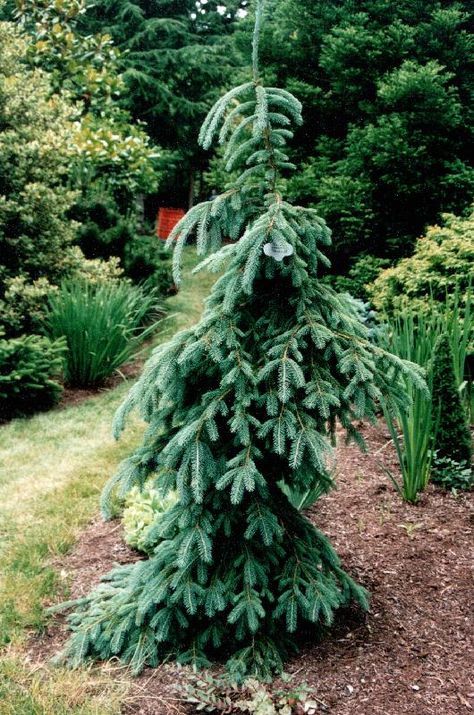 Native to western North America, the giant arborvitae is relatively hardy, 'it grows well in zones 5-9 and does exceptionally in zones 6 to 8,' says Tammy Sons garden expert and CEO at Online Plant Nursery .
Native to western North America, the giant arborvitae is relatively hardy, 'it grows well in zones 5-9 and does exceptionally in zones 6 to 8,' says Tammy Sons garden expert and CEO at Online Plant Nursery .
When it comes to finding a spot for your Giant arborvitae, it is vital to consider the plants needs. 'It prefers full sun though will tolerate light shade and fertile, moist well-drained soil. However, it is somewhat tolerant of heat of dry conditions once established,' advises Melinda Myers.
As a quick growing tree you will either need to factor in a large amount of growing space or you can use it for topiary. Giant arborvitae are one of the best evergreen trees for topiary and will create a beautiful focal point in your garden. Simply prune to shape in the spring, and then prune to maintain come the fall.
10. Olive tree
(Image credit: Christopher Lee)
With their Mediterranean heritage, you would assume that humble olive trees are deciduous. However, they are one of the best evergreen trees for gardens for zones 8 to 10.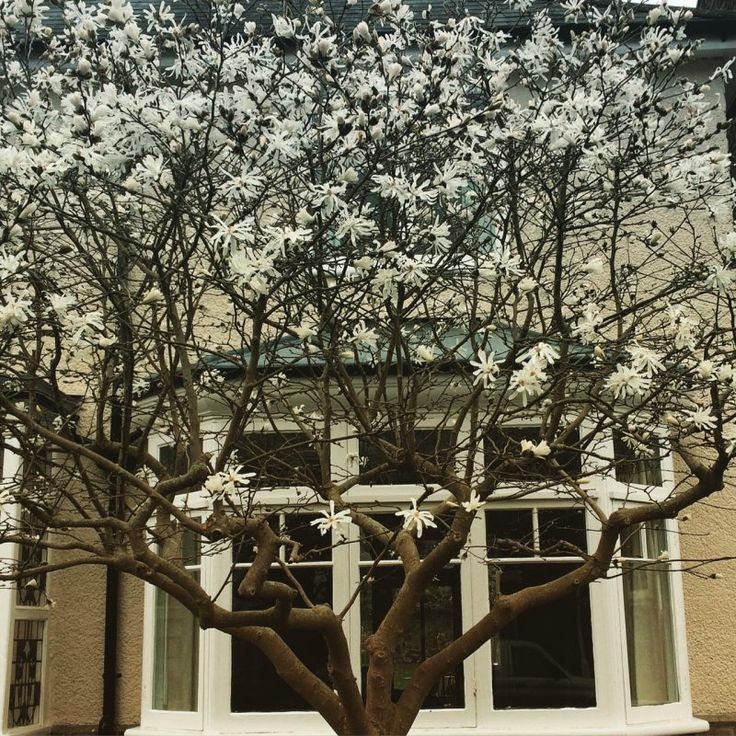 Though they are hardy down to around 10°F, though anything below 45°F will inhibit their fruit production. As a result, they are one of the best trees to grow in pots, as you can move them into a greenhouse for the coldest winter spells.
Though they are hardy down to around 10°F, though anything below 45°F will inhibit their fruit production. As a result, they are one of the best trees to grow in pots, as you can move them into a greenhouse for the coldest winter spells.
When purchasing an olive tree, Guy Barter, chief horticulturist at the RHS, stresses the importance of buying from a reputable supplier that gets stock from areas free of the notifiable disease, Xylella; 'so long as you purchase from a reputable supplier, olives are generally free of pests and diseases'.
Despite being evergreen trees, Guy explains that you shouldn't be surprised if many leaves fall in April, 'this is natural turnover of older leaves to make way for new ones'.
What is the most beautiful evergreen tree?
Magnolia grandiflora is the most beautiful evergreen tree. Erupting in a profusion of blooms in the spring adding beauty and scent, these trees are at their best at the start of spring, heralding the warmer days ahead.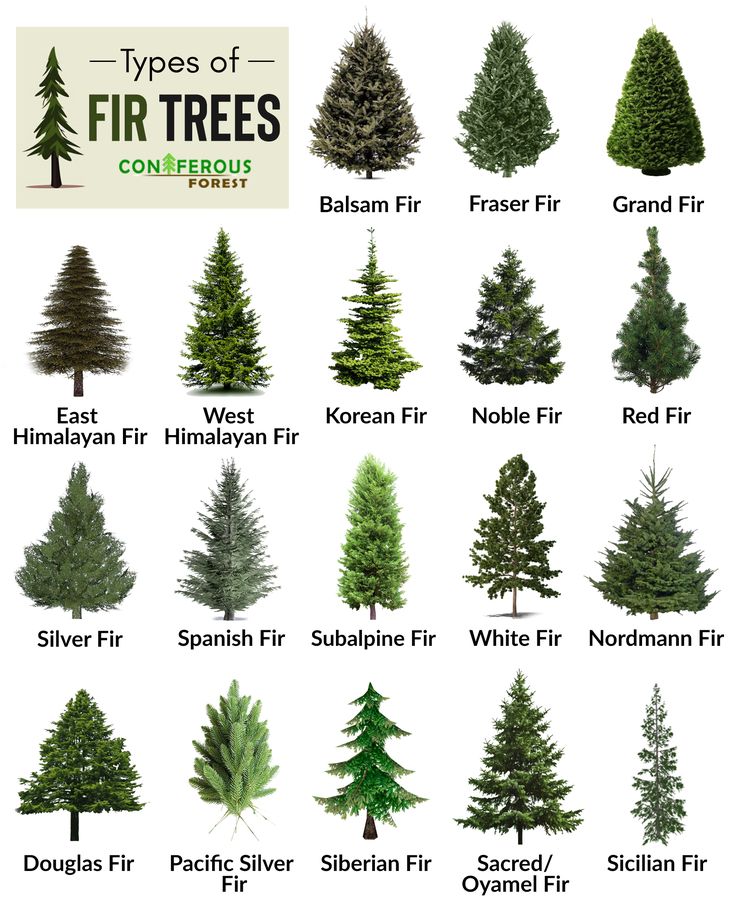 However, for the rest of the year, they are elegant additions to gardens as their broad, glossy leaves offer year-round interest and brings continual life, even in the dead of winter.
However, for the rest of the year, they are elegant additions to gardens as their broad, glossy leaves offer year-round interest and brings continual life, even in the dead of winter.
What is the best evergreen tree for a small garden?
Holly is the best evergreen tree for a small garden as it offers vibrant leaf color, visual interest and a great source of food for visiting wildlife, all the while maintaining a small stature.
While there are some larger varieties, there are also plenty of smaller options, like the Chinese dwarf holly, that are slow-growing. If your garden is particularly small, consider growing evergreen trees in pots as this will help you to keep control of their size.
7 evergreens for the garden: photos and names, what to plant in the country
Evergreens - a win-win option for decorating the site. In summer, their juicy greenery sets off the bright inflorescences of flowering plants, in winter it looks great against the backdrop of white snow.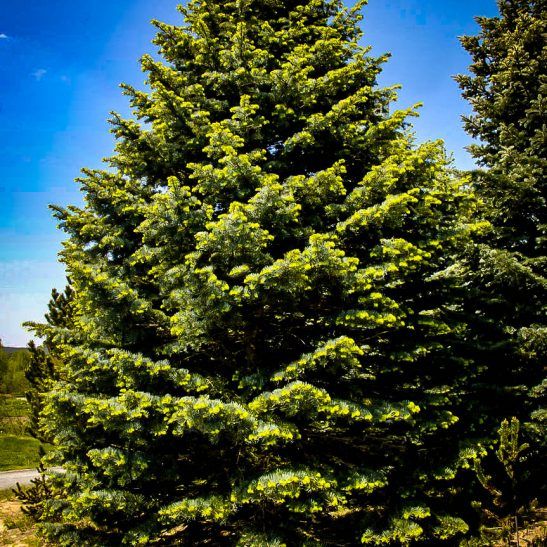 At any time of the year, they decorate the local area. We will understand the features of "undying" cultures and get acquainted with their best types.
At any time of the year, they decorate the local area. We will understand the features of "undying" cultures and get acquainted with their best types.
All about evergreens for the garden
What it is
7 best garden varieties
— Coniferous
- Deciduous
Many people think that only conifers belong to evergreen crops, and even then not all of them. In fact, this is not so. Many plants retain their greenery all year round, but they do it in different ways. In evergreen foliage "lives" for several years. It does not fall either in the warm or in the cold season. This group includes mostly trees and shrubs.
There are also winter green crops. Their foliage remains throughout the winter season, and it completely retains its color. New leaves appear in the spring, after which last year's leaves fall off. This group includes mainly shrubs and herbaceous perennials.
Both groups can be used to decorate your garden with perennial greenery.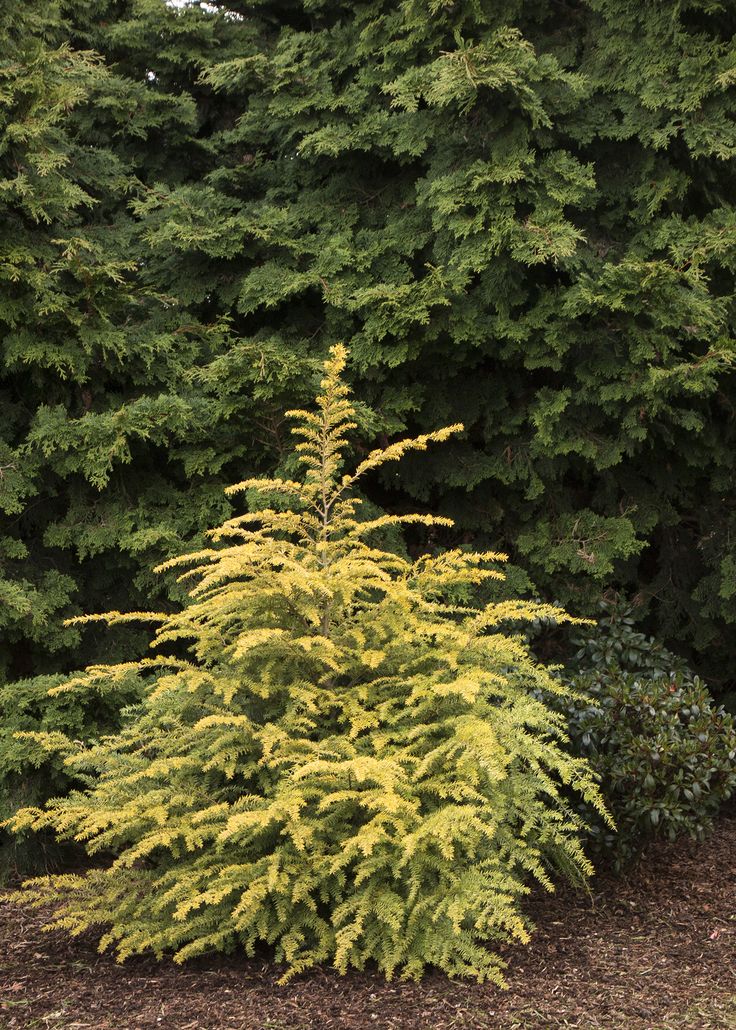 It is important not to confuse them, because the care of crops should be different. Evergreens are less whimsical, better adapt to various conditions. Therefore, they are often chosen for growing on the site. They are suitable for spacious areas and for small areas. There are many varieties of them: from tall to dwarf.
It is important not to confuse them, because the care of crops should be different. Evergreens are less whimsical, better adapt to various conditions. Therefore, they are often chosen for growing on the site. They are suitable for spacious areas and for small areas. There are many varieties of them: from tall to dwarf.
Instagram dachnye_stories
Instagram irivaz777
All crops that preserve greenery all year round can be divided into two groups. Let's talk about each of them.
Coniferous
Their main difference from other plants is the leaves in the form of thin long needles. Some conifers have flat, scaly foliage. The seeds of almost all ripen in cones, the shape, size and shade of which depend on the species. We list the most popular evergreen conifers among gardeners.
1. Spruce
Beautiful fluffy tree with short needles and brown cones. The average tree height is 25-30 m, under favorable conditions it grows up to 50 m. Spruces tolerate shading well, can grow in partial shade and in the sun. Sensitive to humidity and air purity. Prefer slightly alkaline light soils and moderately moist loams. There are more than 45 varieties of conifers. For the site, you can recommend such types.
The average tree height is 25-30 m, under favorable conditions it grows up to 50 m. Spruces tolerate shading well, can grow in partial shade and in the sun. Sensitive to humidity and air purity. Prefer slightly alkaline light soils and moderately moist loams. There are more than 45 varieties of conifers. For the site, you can recommend such types.
- Ohlendorf. A multi-vertex undersized Christmas tree with needles of a golden-green hue. Grows up to 200 cm.
- Akrokona. Compact spruce up to 400 cm, grows very slowly. The needles are dark green, the cones are lilac-raspberry.
- German Nau. Dwarf Christmas tree no more than 150 cm high. The crown is cushion-shaped, the needles are grayish-blue.
Spruces are good in single and group plantings, for example, at the main entrance to the house or as the central figure of a multi-tiered composition. Dwarf and undersized specimens are planted in mixborders or rockeries, they make up hedges.
Pixabay
Instagram green_garden. ua
ua
2. Cypress
Tall conifer with scaly leaves. The crown can be pyramidal or spreading. Dislikes bright sunlight and strong shade. The best option is penumbra. Prefers loose fertile soil mixtures. It does not tolerate waterlogging, in the lowlands it is planted only on drained soils. We list the best varieties for decorating the local area.
- Large-fruited. Tall tree with beautiful yellowish needles. It can grow up to 35-40 m, so pruning is required. It has a very pleasant lemon scent.
- Tuiform. Compact tree with a pyramidal crown of bluish-green color. Its feature is the presence of needle needles, which gradually turn into scaly ones.
- Leyland. Tall fast-growing hybrid with a columnar crown and scaly needles. The trunk is covered with a glossy bark of dark red or brown tone.
Cypresses are undemanding and tolerate pruning well. Low-growing varieties can be used as the basis for a topiary.
Pixabay
ShutterStock
3.
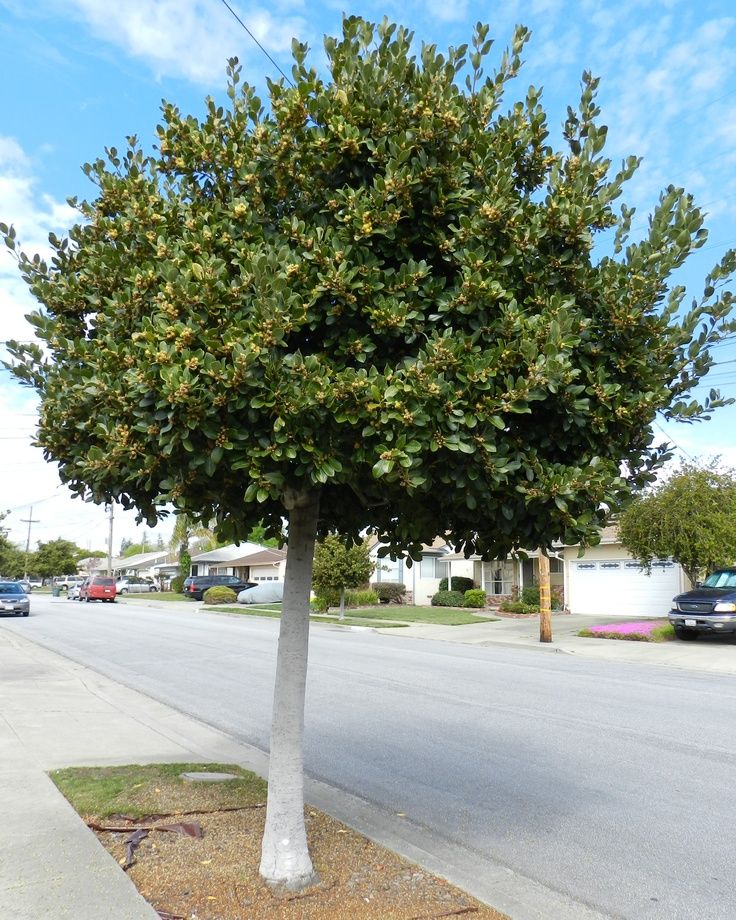 Yew
Yew Beautiful slow growing conifer. There are shrub and woody varieties. The needles are short, soft, very pleasant to the touch, deep green. Forms fruits in the form of scarlet berries. Yew shade-tolerant and unpretentious. It takes root well on any soil, but prefers a fertile neutral substrate without excessive moisture. We list the best varieties for landscaping the site.
- Pointed. Tree-like varieties can reach 20 m, but on average do not grow above 6 m. Shrub species are low, creeping. The needles are crescent-shaped, dark green on top and light on the back.
- Short-leaved. A multi-stemmed slow growing tree growing from 5 to 15 meters. The crown is wide, shaped like a pin. The needles are flat, straight. Berries are bright scarlet.
- Canadian. Frost-resistant variety of shrub type. It grows up to 100-150 cm in height and up to 300-400 cm in width. In winter, the needles acquire a red-brown hue.
All cypress trees tolerate pruning well, which is used in landscape design to create topiaries and park sculptures.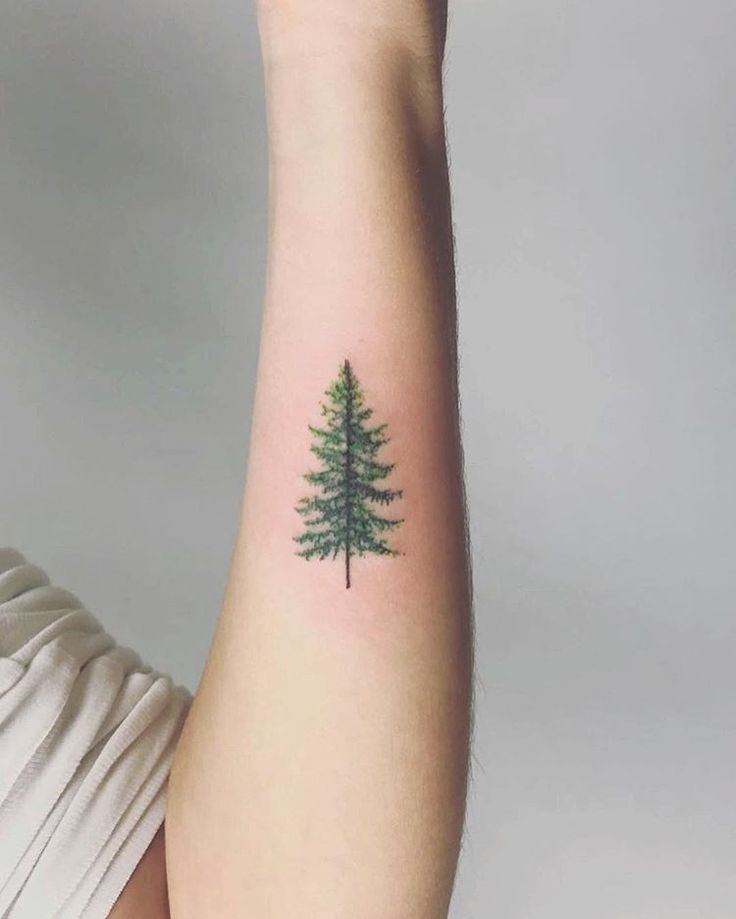 You need to know that cypress cones, bark and needles contain substances that are toxic to humans and animals. Therefore, it is necessary to plant it with caution where children and pets will walk.
You need to know that cypress cones, bark and needles contain substances that are toxic to humans and animals. Therefore, it is necessary to plant it with caution where children and pets will walk.
Pixabay
ShutterStock
ShutterStock
4. Thuja
Decorative conifer with many varieties. Among them there are dwarf shrubs growing up to half a meter, and seventy-meter giant trees. Tui are unpretentious, frost-resistant, grow well in partial shade and shade. Young seedlings have soft needles, which eventually turn into scaly needles. For the adjacent territory, such varieties can be recommended.
- Brabant. Refers to Western varieties. Frost-resistant fast-growing thuja with emerald needles. The crown is pyramidal in shape. Under natural conditions, it can grow up to 40 m, in decorative plantings it does not exceed 4 m.
- Biota. Oriental variety with small needles tightly pressed to the branches. The crown is openwork-pyramidal.
 Cones are small, greenish-blue, dark brown when ripe.
Cones are small, greenish-blue, dark brown when ripe. - Japanese. An ornamental coniferous tree up to 9 m high. The crown is pyramidal, the branches are directed upwards. The needles are emerald green with a silvery sheen, and have a strong pleasant aroma.
Tui are very different, which makes it possible to choose the most suitable type for your site. They go well with other plants, especially boxwood, juniper, barberry. Suitable for arranging hedges, flower beds and single plantings.
Pixabay
Pixabay
Deciduous
Deciduous plants differ from conifers in the presence of lamellar petiole foliage. Its shape and size can be very different. We offer names and photos of deciduous evergreens for the garden.
1. Heather
A monotypic creeping shrub from 25 to 70 cm high. It has many upwardly directed branches covered with small triangular leaves. They are bright green in color, slightly rolled into a tube. Heather blooms in mid-summer. It is covered with bells of a lilac-pink hue. The plant is unpretentious, prefers open areas and slightly acidic soils. Feels good on poor soils. For landscape decoration, you can recommend these varieties of heather.
They are bright green in color, slightly rolled into a tube. Heather blooms in mid-summer. It is covered with bells of a lilac-pink hue. The plant is unpretentious, prefers open areas and slightly acidic soils. Feels good on poor soils. For landscape decoration, you can recommend these varieties of heather.
- Erica. It grows as a semi-shrub, shrub or tree with small, needle-like leaves. Pink or white flowers resemble drooping bells, collected in large brushes.
- Yana. Compact shrub up to 30 cm high. Branches are very dense, straight, directed upwards. The flowers are large, double, bright pink. Flowering begins in early autumn, ends in November.
- Carmen. A compact rounded bush 30-40 cm high. The shoots are covered with very small leaves of a rich dark green tone. Purple or pink flowers are collected in long, up to 10 cm, peduncles.
Heather is suitable for uniform plantings. For a greater decorative effect, you can choose different varieties. The evergreen bush goes well with other crops, for example, with juniper or thuja.
The evergreen bush goes well with other crops, for example, with juniper or thuja.
Pixabay
2. Boxwood
These are slow growing shrubs or trees from 2 to 10 m high. The crown is compact and very dense. The branches are covered with glossy dark green leaves of round or oval shape. Starting from the age of 15-18, boxwood blooms with small yellowish flowers with a pronounced honey aroma. Prefers a slightly acidic or neutral fertile substrate of moderate humidity. Here are the varieties recommended for landscaping.
- Small-leaved. Dwarf bush with a compact crown and densely branched stems. Covered with small rounded leaves. It grows very slowly, a few millimeters per year.
- Colchis. A tree 12-15 m high. Young specimens are not higher than 2 m. The branches directed upwards are covered with oval leaves of emerald green color. It does not tolerate frost well, winter shelter is required.
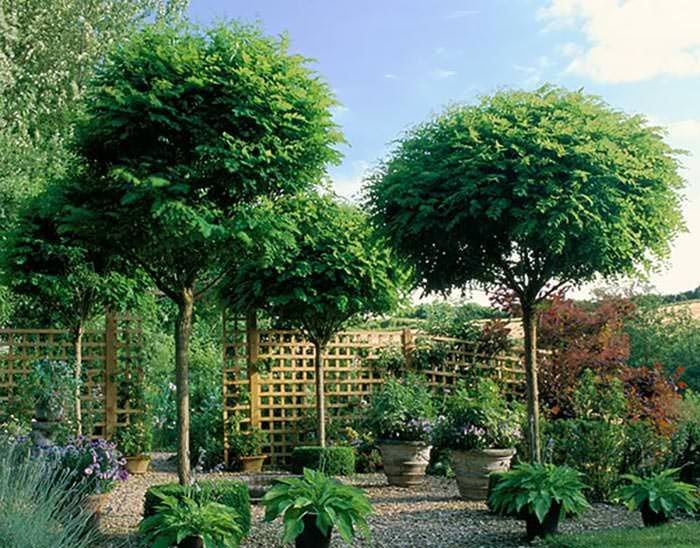
- Balearic. The largest variety. It occurs as a tall shrub or tree with a pyramidal crown. The leaves are ellipsoid, up to 5 cm long. It grows quickly, tolerates frosts down to -18°C.
Boxwood goes well with flowering plants such as hydrangeas, roses or rhododendrons. It is planted in multi-tiered flower beds, in mixborders. It easily tolerates pruning, so it is used to create topiaries, hedges.
Instagram annakotun
Pixabay
3. Honeysuckle
Differs in great species diversity. It happens one- and perennial, grows in the form of a liana or shrub. There are deciduous and leafy varieties in winter. Honeysuckle is decorative and edible. In the latter case, in addition to greens, you can also get a crop of large sweet and sour berries. The shrub is covered with oval-shaped leaves with wavy edges. The flowers, depending on the variety, can be white, pink or reddish. We list the best representatives of decorative honeysuckle.
We list the best representatives of decorative honeysuckle.
- Brown. An ornamental vine used as an evergreen climbing plant for hedges. The leaf blade is rich green above and gray below. Flowers in the form of an elongated bell up to 5 cm in length are collected in brushes. Blooms several times during the season. The fruits are inedible.
- Honeysuckle. A climbing shrub that, when supported, gives rise to creepers up to 6 m long. The leaves are large, elliptical, grayish-green in color. Openwork flowers of blue, purple, yellow or red. The fruits are inedible.
Instagram uiutnyisadi
Pixabay
Undersized honeysuckle looks good in rockeries, upright bushes are used in group plantings. Creepers are planted along arbors, other small architectural forms on the site or in the form of a hedge.
Prepared by
Inna Yasinovskaya
Country house Plants8 fast growing evergreens | Gardening
Trees are one of the first plants to be planted in a garden.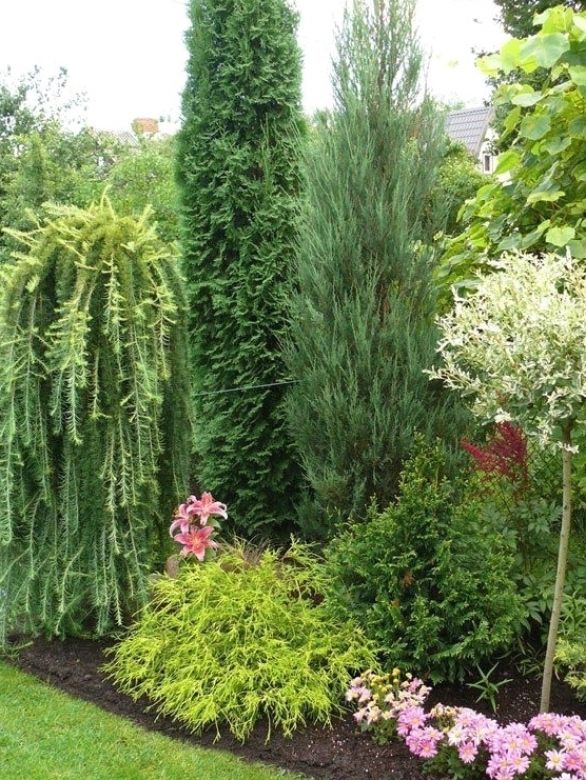 It is they who will reach the largest size and, therefore, will be, as it were, pillars around which the place will come to life. It is for this reason that fast views are often sought, since depending on which areas it is interesting to have a screen that offers us privacy or that cuts the wind a little as soon as possible.
It is they who will reach the largest size and, therefore, will be, as it were, pillars around which the place will come to life. It is for this reason that fast views are often sought, since depending on which areas it is interesting to have a screen that offers us privacy or that cuts the wind a little as soon as possible.
Although we may be very used to seeing plants losing their leaves in autumn and winter, fortunately There are some fast growing evergreen trees that we can plant in the ground.
Do you want Pachira? This evergreen tree thrives indoors. Buy here.
Index
- 1 What are the characteristics of evergreens?
- 2 The best fast growing evergreens
- 2.1 Acacia pale
- 2.2 Runic eucalyptus
- 2.3 Ficus elastica
- 2.4 Grevillea
- 2.5 Royal Delonix0033
- 2.6 Laurus nobilis
- 2.7 Magnolia grandiflora
- 2.
 8 Pachira
8 Pachira - 2.9 Spathodea campanula
What are the characteristics of evergreens?
It is often thought that a tree, evergreen or evergreen plant never loses its leaves, but this is actually not the case. Leaves are living organisms with a limited lifespan, so they will fall off at some point. . This point will depend on the conditions in which plants live and their evolution.
In general, there are many species that choose to shed all their leaves at certain times of the year, either because the temperature is very cold or very warm, or because drought prevents them from maintaining their health. But there are many others who, on the contrary, they shed their leaves little by little The whole year. The last evergreens.
Subscribe to our Youtube channel
The Best Fast Growing Evergreens
If you want to enjoy a garden with evergreen trees, i.e. those that will provide shade throughout the year, take a look at our selection:
Acacia pale
Image - Wikimedia / J Brew
It is difficult to collect just one type of acacia: they all grow quickly and bloom spectacularly.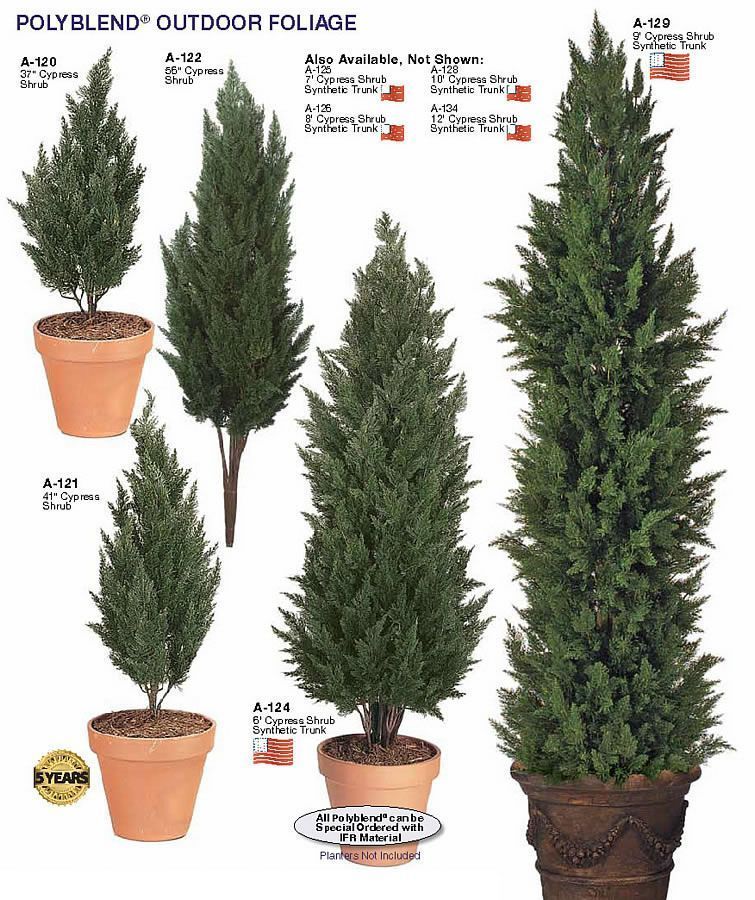 But, unfortunately, some of them are considered invaders in Spain, such as Acacia deibata or Longleaf acacia . So we're left with Acacia pale that is a tree about 10 meters tall native to the Blue Mountains in New South Wales, Australia. It produces compound leaves of 30 to 40 pairs of green leaflets. Its flowers are small, yellow and fragrant.
But, unfortunately, some of them are considered invaders in Spain, such as Acacia deibata or Longleaf acacia . So we're left with Acacia pale that is a tree about 10 meters tall native to the Blue Mountains in New South Wales, Australia. It produces compound leaves of 30 to 40 pairs of green leaflets. Its flowers are small, yellow and fragrant.
Resistant to frost down to -7ºС.
Article subject:
What are the characteristics of the acacia tree?
Runic Eucalyptus
Image - Flickr / Widespread
Known as cider gum or ornamental eucalyptus, it is a fast growing evergreen tree native to Australia and Tasmania. can exceed 30 meters in height . Its leaves turn blue-gray as they mature, and the flowers are clustered in umbellate inflorescences.
Article Subject:
Eucalyptus Cider (Eucalyptus gunnii)
It has an invasive root system, so it should only be planted in large gardens, at least ten meters away from walls, pipes, etc.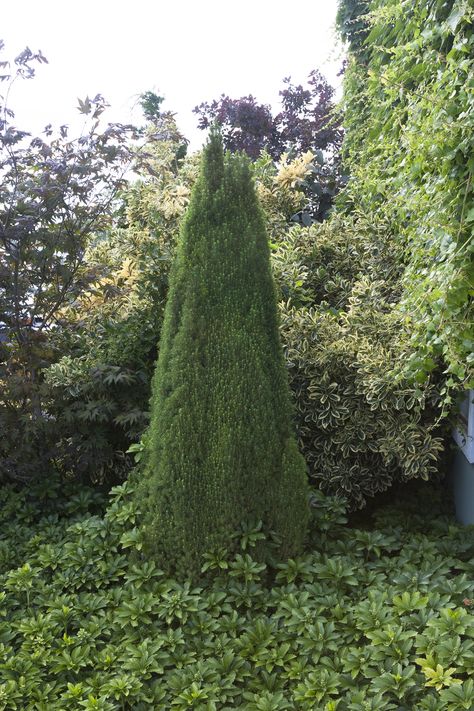 Can withstand up to -18ºC.
Can withstand up to -18ºC.
Ficus elastica
Image - Wikimedia / PseudoscienceFTL
Ficus They usually have a very bad reputation when they are in the garden because their root system is quite invasive. But if you have a large plot of land where you can plant at least ten meters away from walls, pipes and so on, one of the most beautiful views is undoubtedly Ficus elastic . Known as the rubber tree or rubber tree, it is a fast growing shade tree native to India and western Indonesia. Reaches a height of 40 meters and develops large green leaves about 35 cm long and 15 cm wide.
Withstands down to -7ºC but prefers warmer climates. get yours here.
Article subject:
Ficus elastica or homero
Grevillea
Image - Wikimedia / PseudoscienceFTL
Grevillea is a genus of fast growing evergreen shrubs and mostly trees native to Australia and Papua New Guinea that can reach a height of 1 to 50 meters depending on the species.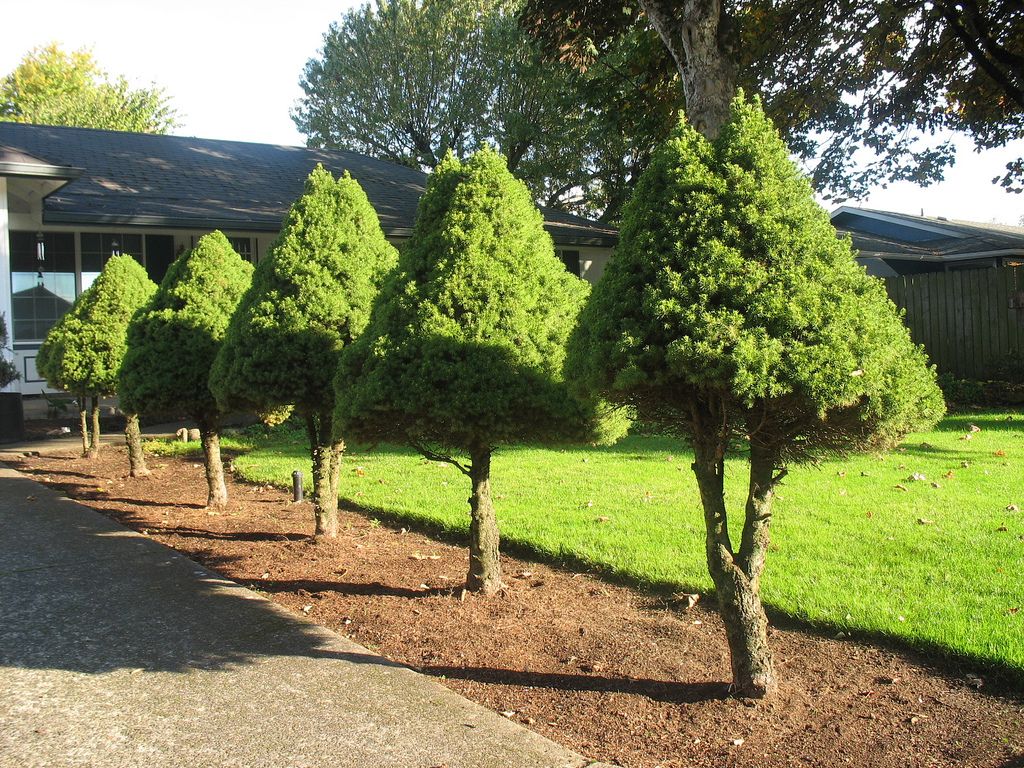 Any of them will give you a lot of fun, but for this list we recommend Grevillea Banksii that is a small tree 7 meters high with feathery leaves that produce bright red or creamy white flowers throughout the year.
Any of them will give you a lot of fun, but for this list we recommend Grevillea Banksii that is a small tree 7 meters high with feathery leaves that produce bright red or creamy white flowers throughout the year.
Withstands down to -4ºC.
Article subject:
Grevillea
Royal Delonix
Image - Wikimedia / Anna Anichkova
Known as bright, bright, hidden or tabachine, this tree, growing in Madagascar, can be many, semi-annual, perennial, depending on the climate or deciduous. Why is it on this list? Well, because if you live in an area with a frost-free climate and it often rains, then you will have it with leaves all year round. Grows up to 12 meters in height. , developing an umbrella crown consisting of green leaves. The flowers are large, about 8 cm long, red or orange, depending on the variety.
Not resistant to frost. Mature and acclimatized specimens can survive down to -1ºC if this is short term and punctual, but to preserve the leaves it is necessary that the temperature does not fall below 10ºC.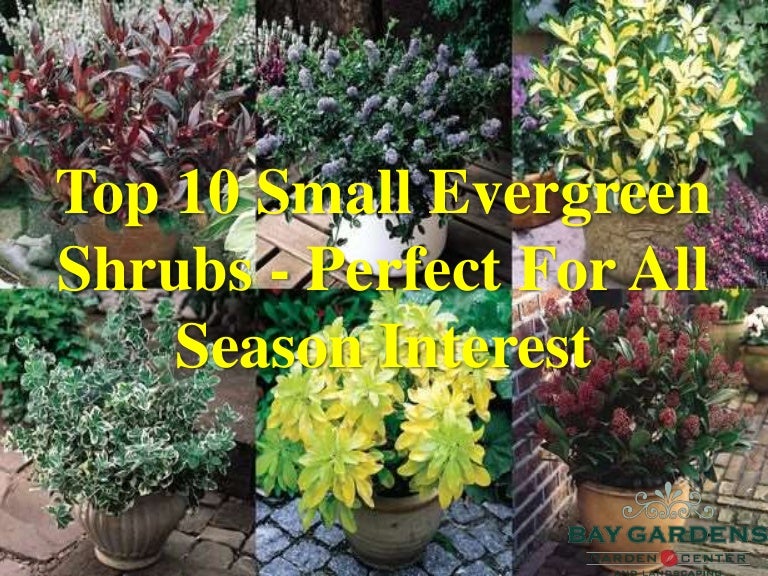 You can buy seeds here.
You can buy seeds here.
Article subject:
Flamboyan
Laurus nobilis
Laurel is an evergreen tree native to the Mediterranean. reaches 5 to 10 meters in height . The crown is dense, formed by bluish-lanceolate fragrant leaves. In spring, it produces small yellowish flowers clustered in umbellate inflorescences.
Withstands temperatures down to -7ºC. Want one? Click here.
Article subject:
Laurus
Magnolia grandiflora
Image - Wikimedia / SABENCIA Guillermo Cesar Ruiz
This is probably the slowest growth on this list, but not by much. I can tell you that I have one in a pot and it grows at a rate of 10-20 cm per year. This tree is a miracle. Found wild in the southeastern United States, and while can reach 35 meters in height, is normal to stay at 10-12m. Its flowers, which sprout in spring, are very large, up to 12 cm wide, white and very fragrant.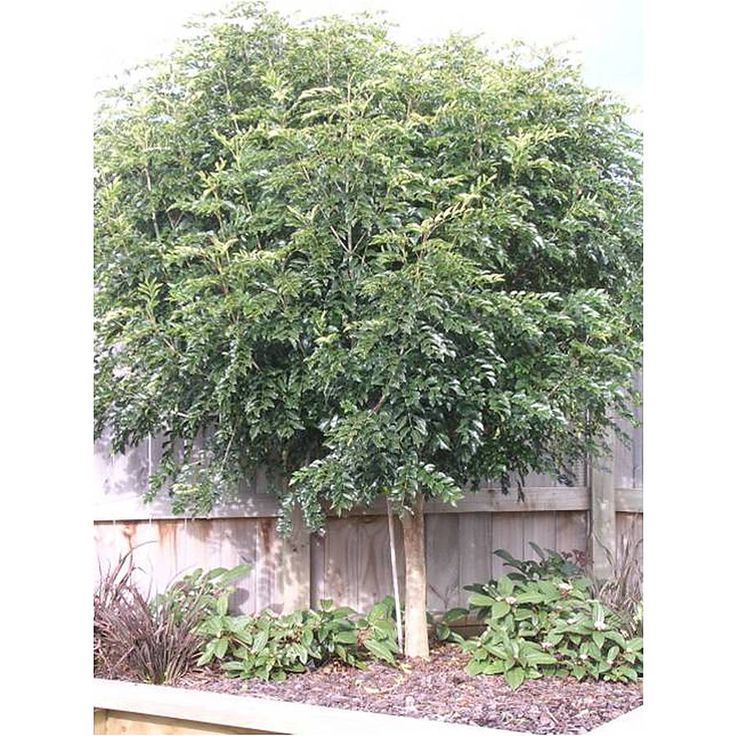
Withstands down to -6ºC.
Article subject:
Magnolia tree (Magnolia grandiflora)
Pachira
La Pachira - evergreen tree, Can reach a height of 10 meters, or even exceed it. . It has beautiful green membranous leaves and is usually sold in a pot with several seedlings whose trunks are intertwined. It is a species that does not tolerate cold, so it must be kept indoors if the temperature drops below 0 degrees.
Buy here.
Campanula spathodea
Known as the Gaboon tulip tree, African tulip tree, fontana or galeana, it is a native tree in the intertropical zone of Africa that can reach a height of 7 to 25 meters . The crown is rounded, not very wide, formed by branches, from which greenish pinnate leaves sprout. The flowers are beautiful, red or orange, bloom in spring.
Very sensitive to cold. It can withstand up to -1ºC only with specific and short-term frosts.
